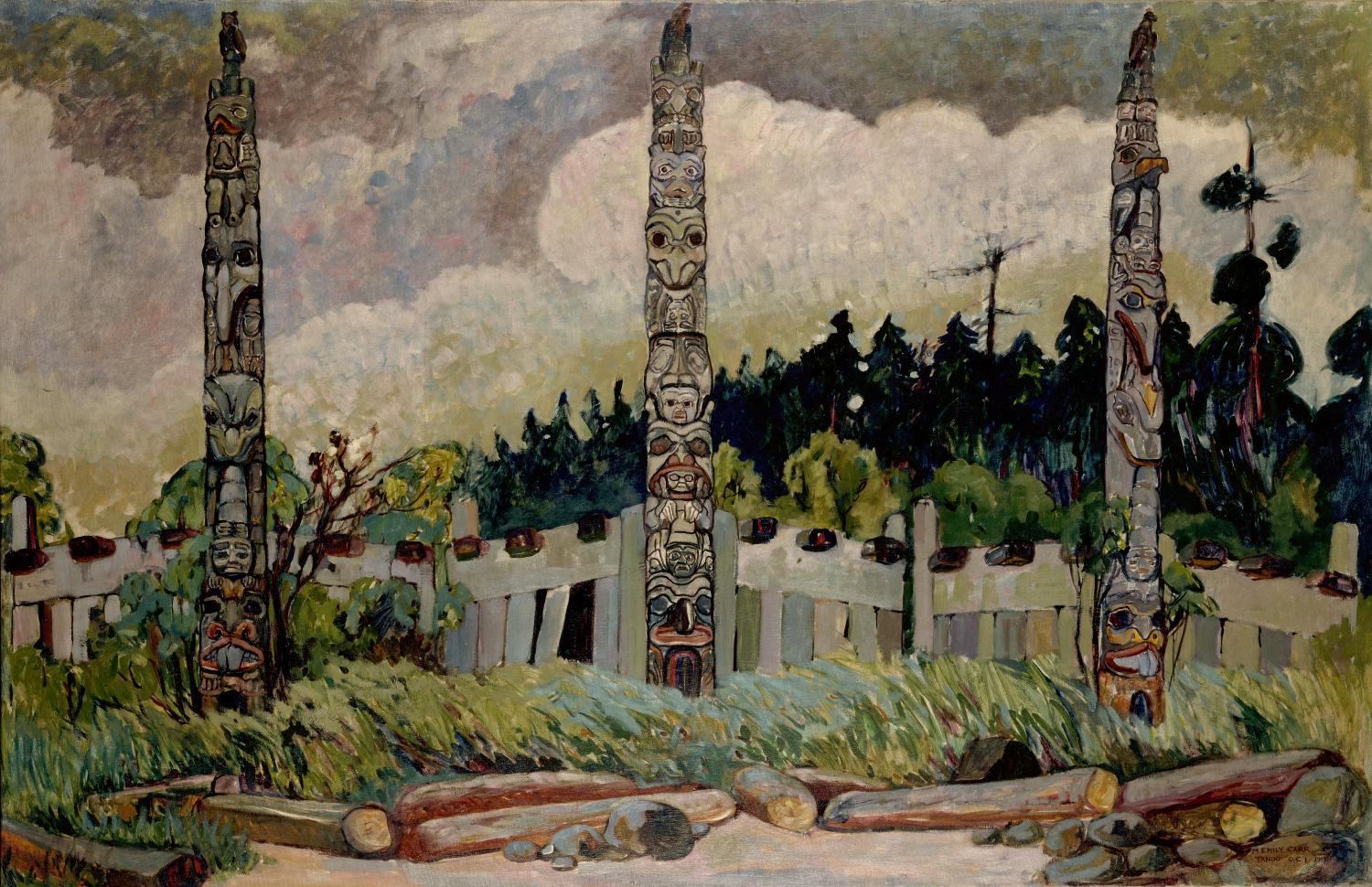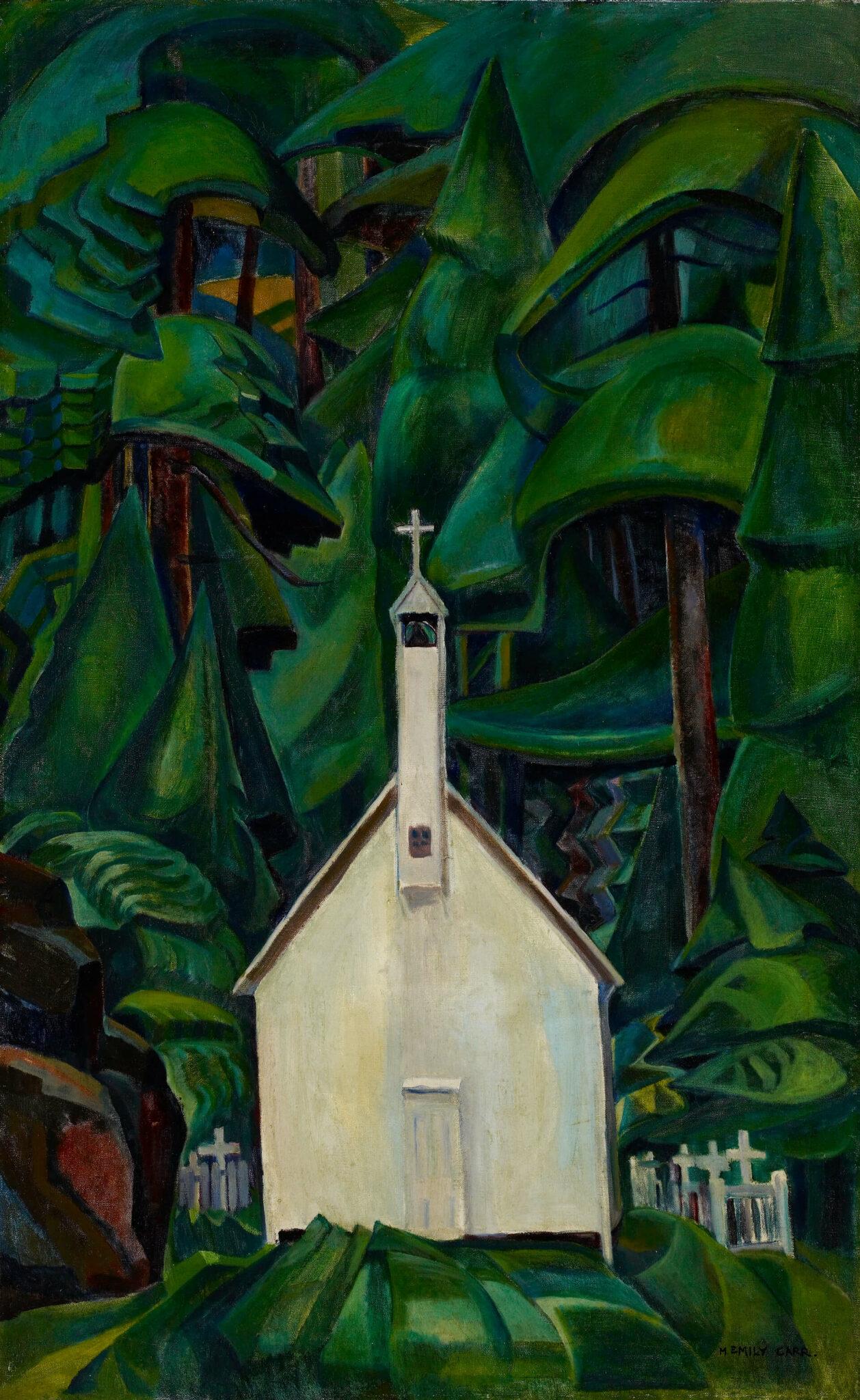Emily Carr
A little-known landscape painter gains recognition in her final decades
Date: 1927
Emily Carr captured British Columbia’s landscape like few others ever have. Towering conifers, churning skies and weathered totem poles fill her paintings, all laden with fantastic swirls of green, blue and brown. Carr didn’t try to replicate the world exactly as it was. Instead, she brought the drama of the Pacific Northwest to the fore. She wanted the viewer to experience the same overwhelming emotion she felt in nature.
“What do these forests make you feel?” she wrote in 1934. “Their weight and density, their crowded orderliness. There is scarcely room for another tree, and yet there is space around each. They are profoundly solemn yet upliftingly joyous…” Though it took time, eventually, Carr’s paintings struck a chord, and her artwork is now celebrated globally. But critics have also come to question her legacy, accusing Carr of cultural appropriation and perpetuating the harmful myth of the “vanishing Indian.”
Carr was born to British immigrants in Victoria in 1871. She showed promise as an artist during her childhood. In 1889, an 18-year-old Carr travelled to San Francisco to pursue her passion at the California School of Design, then a very rare voyage for a young woman to make on her own. Though she later studied art in England and France, she always made her way back to Victoria, near the coastal forests that feature so prominently in her paintings. It was following her time in France when Carr began to develop her unique brand of landscape painting, one heavily influenced by French Post-Impressionism.
In 1912, Carr travelled north to document the art and remote villages of the Haida, Gitxsan and Tsimshian peoples. Carr tried to sell this new work to the provincial government, emphasizing how it showed “real art treasures of a passing race.” But she received no interest. Though well-received in Vancouver, the government considered her work too abstract. Over the next 14 years, she painted far less and instead spent her time running a boarding house in Victoria, raising sheepdogs, and dabbling in pottery and rug-making.
Carr’s big break came in 1927 when the 55-years-old’s work was exhibited at the National Gallery of Canada in Ottawa. At the exhibit, Carr met the Group of Seven, a renowned club of male Canadian landscape painters with which she is closely associated. The recognition of her long-neglected work and a newfound connection with like-minded artists buoyed Carr. The next 15 odd years saw the eccentric iconoclast create her most famous works, tapping deep into her passion for nature and Indigenous art. “I am painting on my own vision now, thinking of no one else’s approach, trying to express my own reactions,” the artist wrote in her journal in 1934.
Since her death in 1945, Carr has become a Canadian and feminist icon. But her life and art have also come under scrutiny. Compared to many of her non-Indigenous contemporaries, Carr was a rarity. She had Indigenous friends and recognized the value of Indigenous art like few others had. But critics like Haida/Tsimshian scholar Marcia Crosby say Carr also deliberately promoted the “dying race” trope. In her memoirs, the artist chose to focus on abandoned Haida villages over thriving Gitxan communities, where traditional Indigenous culture remained very much alive. Her paintings, particularly her later works, communicate this same idea of a bygone society. Totem poles and other Indigenous structures often stand solemnly alone, enveloped by overgrown green, no sign of humans. “Only a few more years,” Carr wrote about totem poles in 1913, “and they will be gone forever, into silent nothingness.”
With policies like a ban on potlatches and the residential school system, it’s no question, Indigenous communities in Canada faced immense persecution during Carr’s lifetime. However, her fatalistic prediction never came to pass. Indigenous culture has since experienced a spirited resurgence.
Sources:
1. Baldissera, Lisa. Emily Carr, Vanquished, 1930. Art Canada Institute, www.aci-iac.ca/art-books/emily-carr/key-works/vanquished.
2. Cole, Douglas. “The Invented Indian/The Imagined Emily.” BC Studies, no. 125 & 126, 0AD, ojs.library.ubc.ca/index.php/bcstudies/article/view/1530.
3. Dawn, Leslie. “The Enigma of Emily Carr: A Review Essay.” BC Studies, no. 152, 0AD, doi:http://ojs.library.ubc.ca/index.php/bcstudies/article/download/672/718.
4. Emily Carr - BC Archives Time Machine. Royal B.C. Museum, royalbcmuseum.bc.ca/exhibits/bc-archives-time-machine/galler11/frames/carr.htm.
5. Emily Carr. Vancouver Art Gallery, www.virtualmuseum.ca/sgc-cms/expositions-exhibitions/emily_carr/en/about/artistic_context.php.
6. Emily Carr: Deep Forest. Vancouver Art Gallery, Winter 2013, vagallery.s3.us-west-2.amazonaws.com/wp-content/uploads/2019/06/25210733/carr-deep-forest-study-guide.pdf.
7. Emily Carr's Quest to Record Canadian Indigenous Culture Took Her to Places Even the Mounties Dared Not Go. National Post, 4 Nov. 2014, nationalpost.com/entertainment/emily-carrs-quest-to-record-canadian-indigenous-culture-took-her-to-places-even-the-mounties-dared-not-go.
8. Shadbolt, Doris. “Emily Carr.” The Canadian Encyclopedia, 23 June 2013, www.thecanadianencyclopedia.ca/en/article/emily-carr.
9. Tippett, Maria. Carr, Emily. Dictionary of Canadian Biography, www.biographi.ca/en/bio/carr_emily_17E.html.
10. “What's in a Name?” Art Gallery of Ontario, 23 May 2018, ago.ca/agoinsider/whats-name.






